Bridge Cable Sockets Market
Bridge Cable Sockets Market Size and Share Forecast Outlook 2025 to 2035
Bridge cable sockets market is projected to grow from USD 240.0 million in 2025 to USD 410.0 million by 2035, at a CAGR of 5.9%. Wedge Sockets will dominate with a 38.0% market share, while steel alloy will lead the material segment with a 62.0% share.
Bridge Cable Sockets Market Forecast and Outlook 2025 to 2035
The global bridge cable sockets market is valued at USD 240.0 million in 2025. It is slated to reach USD 410.0 million by 2035, recording an absolute increase of USD 170.0 million over the forecast period. This translates into a total growth of 70.8%, with the market forecast to expand at a CAGR of 5.9% between 2025 and 2035.
The overall market size is expected to grow by nearly 1.7 times during the same period, supported by increasing bridge construction projects, growing adoption of cable-stayed bridge technologies, and rising focus on advanced structural hardware solutions across diverse suspension bridges, cable-stayed bridges, and civil engineering structures.
Quick Stats for Bridge Cable Sockets Market
- Bridge Cable Sockets Market Value (2025): USD 240.0 million
- Bridge Cable Sockets Market Forecast Value (2035): USD 410.0 million
- Bridge Cable Sockets Market Forecast CAGR: 5.9%
- Leading Type in Bridge Cable Sockets Market: Wedge Sockets
- Key Growth Regions in Bridge Cable Sockets Market: North America, Europe, and Asia Pacific
- Key Players in Bridge Cable Sockets Market: Bridon-Bekaert, Valmont, Herrenknecht, DYWIDAG, Freyssinet, VSL
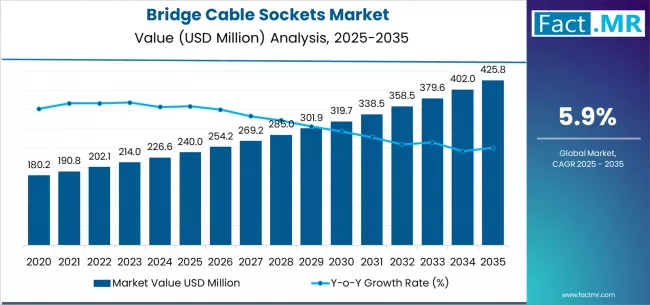
Between 2025 and 2030, the market is projected to expand from USD 240.0 million to USD 315.0 million, resulting in a value increase of USD 75.0 million, which represents 44.1% of the total forecast growth for the decade. This phase of development will be shaped by increasing infrastructure development and bridge modernization programs, rising adoption of advanced cable support technologies, and growing demand for high-strength structural components in bridge construction and civil engineering applications.
Bridge Cable Sockets Market Key Takeaways
| Metric | Value |
|---|---|
| Estimated Value in (2025E) | USD 240.0 million |
| Forecast Value in (2035F) | USD 410.0 million |
| Forecast CAGR (2025 to 2035) | 5.9% |
From 2030 to 2035, the market is forecast to grow from USD 315.0 million to USD 410.0 million, adding another USD 95.0 million, which constitutes 55.9% of the overall ten-year expansion. This period is expected to be characterized by the expansion of smart infrastructure technologies and monitoring systems, the development of next-generation cable socket designs and high-performance materials, and the growth of specialized applications in mega-bridge projects and advanced structural engineering sectors.
Between 2020 and 2025, the market experienced steady growth from USD 160.0 million to USD 240.0 million, driven by increasing global infrastructure investment and growing recognition of advanced structural hardware as essential components for enhancing bridge safety and providing comprehensive structural support across diverse suspension bridge, cable-stayed bridge, and civil engineering applications. The market developed as bridge engineers and construction contractors recognized the potential for advanced socket technology to enhance structural reliability, improve load distribution, and support bridge safety objectives while meeting structural engineering requirements.
Why is the Bridge Cable Sockets Market Growing?
Market expansion is being supported by the increasing global demand for bridge construction and infrastructure development driven by urbanization and transportation network expansion, alongside the corresponding demand for advanced structural hardware components that can enhance bridge safety, enable efficient load transfer, and maintain structural integrity across various suspension bridges, cable-stayed bridges, infrastructure projects, and civil engineering structures. Modern bridge engineers and construction contractors are increasingly focused on implementing socket solutions that can improve structural performance, enhance safety margins, and provide reliable cable connections in demanding structural environments.
The growing focus on mega-bridge projects and advanced structural designs is driving demand for bridge cable sockets that can support high-load applications, enable complex cable configurations, and ensure comprehensive structural effectiveness. Infrastructure industry manufacturers' preference for engineered hardware systems that combine structural excellence with safety reliability and installation efficiency is creating opportunities for innovative bridge socket implementations. The rising influence of infrastructure resilience and seismic design requirements is also contributing to increased adoption of bridge cable sockets that can provide superior structural performance without compromising bridge safety or construction efficiency.
Segmental Analysis
The market is segmented by type, material, and end use. By type, the market is divided into wedge sockets, clip sockets, and strand grips. Based on material, the market is categorized into steel alloy, stainless, and galvanized. By end use, the market is split between suspension bridges, cable-stayed bridges, and other civil structures.
By Type, the Wedge Sockets Segment Leads the Market
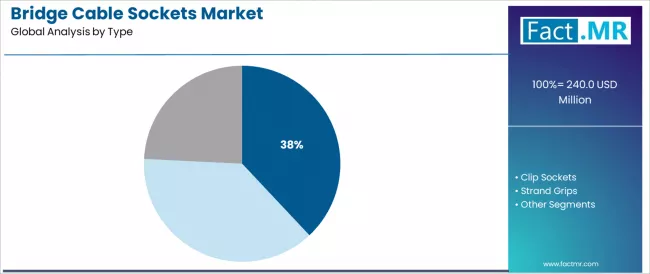
The wedge sockets type segment is projected to maintain its leading position in the market in 2025 with a 38.0% market share, reaffirming its role as the preferred socket technology for heavy-duty bridge applications and comprehensive cable anchoring. Bridge engineers and structural contractors increasingly utilize wedge sockets for their superior load-bearing capabilities, excellent cable gripping performance, and proven reliability in high-stress bridge applications while maintaining structural safety and installation efficiency. Wedge socket technology's established performance and structural versatility directly address the bridge engineering requirements for reliable cable termination and consistent load transfer across diverse bridge applications and structural configurations.
This type segment forms the foundation of modern bridge cable systems, as it represents the socket technology with the greatest contribution to heavy-duty cable anchoring and established performance record across multiple bridge applications and structural protocols. Bridge engineering investments in structural hardware technologies continue to strengthen adoption among engineers and contractors. With increasing demand for high-capacity structural solutions and reliable cable connections, wedge sockets align with both performance objectives and safety requirements, making them the central component of comprehensive bridge cable strategies.
By Material, the Steel Alloy Segment Dominates Market Demand
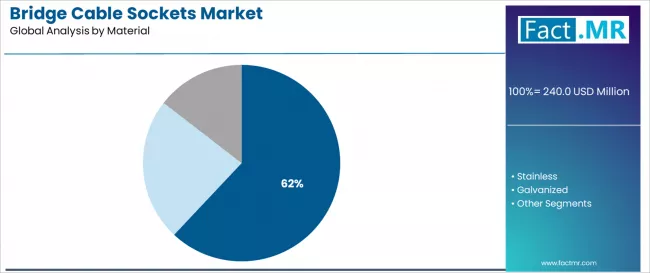
The steel alloy material segment is projected to represent the largest share of bridge cable socket demand in 2025 with a 62.0% market share, underscoring its critical role as the primary material choice for bridge socket adoption across heavy-duty applications, high-load structures, and demanding bridge installations. Structural engineers prefer steel alloy materials due to their exceptional strength characteristics, comprehensive durability properties, and ability to support extreme structural loads while maintaining material reliability and corrosion resistance objectives. Positioned as essential materials for modern bridge structures, steel alloy sockets offer both structural advantages and performance benefits.
The segment is supported by continuous innovation in metallurgy technology and the growing availability of high-performance alloy systems that enable superior structural performance with enhanced strength properties and improved durability characteristics. Bridge professionals are investing in comprehensive material programs to support increasingly demanding structural standards and bridge requirements for reliable and long-lasting cable connections. As bridge engineering advances and load requirements increase, the steel alloy material segment will continue to dominate the market while supporting advanced socket utilization and structural optimization strategies.
By End Use, the Suspension Bridges Segment Commands Market Leadership
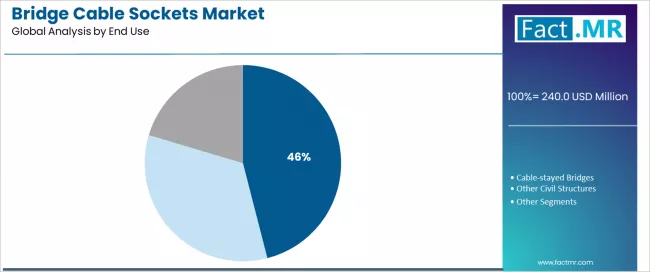
The suspension bridges end use segment is projected to maintain the largest share of bridge cable socket applications in 2025 with a 46.0% market share, highlighting its fundamental role in iconic bridge structures, long-span applications, and major infrastructure projects. Bridge contractors prefer suspension bridge applications for their comprehensive engineering challenges, specialized hardware requirements, and proven demand patterns with substantial project values and reliable construction activity. This segment represents the backbone of bridge cable socket demand across multiple infrastructure applications and bridge types.
The suspension bridges segment benefits from ongoing technological advancement in bridge engineering systems and the expanding adoption of advanced cable technologies in major infrastructure applications. Suspension bridge demand continues to grow due to increasing infrastructure development requirements, rising long-span crossing needs, and the demand for bridge solutions that can support massive structural loads while maintaining engineering excellence and construction reliability. As bridge engineering becomes more sophisticated and span requirements increase, the suspension bridges segment will continue to drive market growth while supporting advanced socket integration and structural optimization strategies.
What are the Drivers, Restraints, and Key Trends of the Bridge Cable Sockets Market?
The bridge cable sockets market is advancing steadily due to increasing global infrastructure investment and bridge construction activities driven by urbanization and transportation development, growing adoption of advanced structural engineering technologies that require specialized hardware components providing enhanced load transfer and structural reliability across diverse suspension bridges, cable-stayed bridges, infrastructure projects, and civil engineering structures. The market faces challenges, including high project costs and long development cycles, complex regulatory approval processes for bridge projects, and competition from alternative cable termination methods and structural systems. Innovation in smart monitoring technologies and advanced materials continues to influence product development and market expansion patterns.
Expansion of Mega-Bridge Projects and Complex Structures
The growing development of mega-bridge projects is driving demand for advanced structural hardware that addresses extreme engineering requirements including massive load capacities, complex cable configurations, and comprehensive safety margins in major infrastructure and bridge construction settings. Mega-bridge applications require advanced cable sockets that deliver superior structural performance across multiple engineering parameters while maintaining safety reliability and installation precision. Infrastructure developers are increasingly recognizing the competitive advantages of specialized hardware integration for project success and structural optimization, creating opportunities for innovative structural components specifically designed for next-generation bridge engineering and mega-infrastructure applications.
Integration of Smart Monitoring and Structural Health Systems
Modern bridge operators are incorporating structural health monitoring systems and intelligent maintenance technologies to enhance bridge performance, address safety requirements, and support comprehensive infrastructure management objectives through optimized structural monitoring and intelligent maintenance guidance. Leading companies are developing smart socket platforms, implementing monitoring integration systems, and advancing structural technologies that maximize safety effectiveness while supporting predictive maintenance approaches. These technologies improve safety outcomes while enabling new market opportunities, including smart infrastructure applications, monitoring integration methods, and intelligent bridge management systems.
Development of Advanced Materials and High-Performance Alloys
The expansion of advanced metallurgy methods, high-performance materials, and precision engineering technologies is driving demand for bridge cable sockets with enhanced strength properties and specialized structural characteristics. These advanced applications require specialized socket platforms with precise engineering control and exceptional structural reliability that exceed traditional hardware requirements, creating premium market segments with differentiated structural propositions. Manufacturers are investing in advanced materials capabilities and engineering system development to serve emerging high-performance applications while supporting innovation in advanced bridge engineering and structural hardware sectors.
Analysis of the Bridge Cable Sockets Market by Key Countries
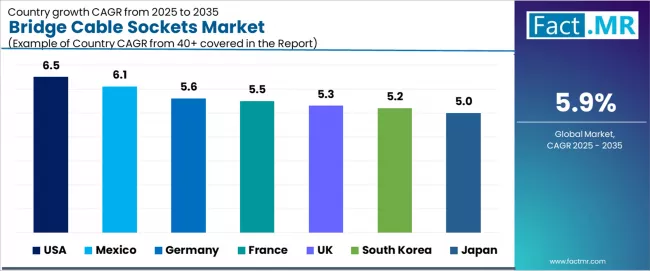
| Country | CAGR (2025-2035) |
|---|---|
| USA | 6.5% |
| Mexico | 6.1% |
| Germany | 5.6% |
| France | 5.5% |
| UK | 5.3% |
| South Korea | 5.2% |
| Japan | 5.0% |
The market is experiencing robust growth globally, with the USA leading at a 6.5% CAGR through 2035, driven by expanding infrastructure investment and growing bridge modernization programs, alongside increasing investment in advanced structural technologies and major bridge construction projects. Mexico follows at 6.1%, supported by infrastructure development initiatives, expanding construction sector, and increasing demand for advanced structural hardware in domestic and regional markets. Germany shows growth at 5.6%, emphasizing structural engineering innovation, infrastructure excellence, and advanced construction development. France demonstrates 5.5% growth, supported by infrastructure system advancement and engineering technology adoption. The UK records 5.3%, focusing on infrastructure innovation and engineering technology development. South Korea exhibits 5.2% growth, emphasizing infrastructure modernization and structural engineering applications. Japan shows 5.0% growth, emphasizing quality standards and specialized structural applications.
USA Leads Global Market Growth with Infrastructure Investment and Engineering Innovation
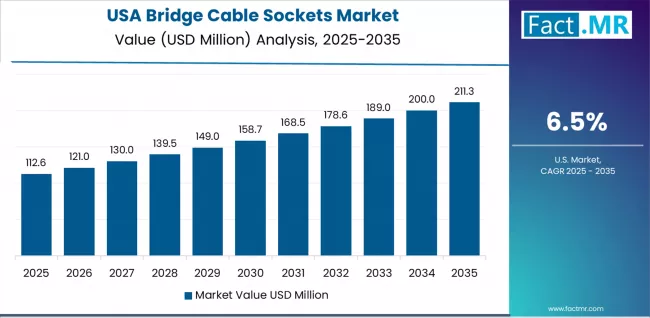
The USA is projected to exhibit strong growth with a CAGR of 6.5% through 2035, driven by expanding infrastructure investment and rapidly growing bridge construction sector supported by federal infrastructure programs and advanced structural engineering technology adoption. The country's substantial infrastructure development and increasing investment in bridge technologies are creating substantial demand for cable socket solutions. Major bridge contractors and structural engineers are establishing comprehensive socket capabilities to serve both domestic markets and export opportunities.
- Strong infrastructure expansion and growing bridge construction are driving demand for bridge cable sockets throughout major infrastructure regions including California, New York, and the Interstate bridge corridors, supporting both highway bridge projects and urban infrastructure developments.
- Growing infrastructure investment and bridge modernization programs are supporting the rapid adoption of cable socket technologies among contractors seeking enhanced structural capabilities and engineering performance excellence in competitive infrastructure markets.
Mexico Demonstrates Infrastructure Integration with Construction Development
Mexico is expanding at a CAGR of 6.1%, supported by infrastructure modernization initiatives, growing construction sector, and strategic position as an infrastructure development hub for Latin American markets. Mexico's construction development and infrastructure technology advancement are driving sophisticated cable socket capabilities throughout infrastructure sectors. Leading construction companies and infrastructure contractors are establishing extensive installation capabilities to address growing domestic infrastructure and regional market demand.
- Infrastructure modernization and expanding construction activities are creating opportunities for cable socket adoption across infrastructure systems, construction projects, and engineering centers in major development regions including Mexico City and infrastructure development zones.
- Growing construction sector and infrastructure technology expansion are supporting the adoption of advanced structural hardware among contractors seeking to serve both domestic and international markets while maintaining engineering standards and construction effectiveness.
Germany Demonstrates Structural Engineering Excellence with Infrastructure Innovation
Germany is expanding at a CAGR of 5.6%, driven by the country's structural engineering leadership, infrastructure innovation capabilities, and precision manufacturing excellence supporting high-performance cable socket applications. Germany's engineering expertise and infrastructure innovation are driving demand for specialized cable socket solutions throughout construction sectors. Leading structural manufacturers and infrastructure providers are establishing comprehensive innovation programs for next-generation bridge technologies.
- Advanced structural engineering development and infrastructure innovation requirements are creating demand for specialized cable sockets among contractors and engineering companies seeking enhanced structural performance and safety reliability in competitive European markets.
- Strong engineering industry expertise and infrastructure technology leadership are supporting the adoption of advanced cable socket technologies and structural optimization across infrastructure facilities throughout major construction regions including North Rhine-Westphalia and Bavaria.
France Shows Infrastructure Excellence and Engineering Technology Innovation Leadership
France is expanding at a CAGR of 5.5%, supported by the country's infrastructure system excellence, engineering technology innovation leadership, and pioneering construction advancement initiatives including eco-friendly infrastructure and advanced engineering development. France's infrastructure heritage and engineering expertise are supporting investment in advanced cable socket technologies. Major infrastructure providers and construction companies are establishing comprehensive engineering programs incorporating cable socket advancement and structural innovation.
- Advanced infrastructure innovation and engineering technology capabilities are creating demand for premium cable socket products supporting structural excellence, infrastructure advancement, and engineering optimization throughout major infrastructure and engineering technology regions.
- Strong infrastructure focus and engineering technology leadership are driving the adoption of advanced structural hardware and infrastructure enhancement throughout construction facilities across engineering excellence clusters and innovation zones.
UK Focuses on Infrastructure Innovation and Engineering Technology Development
The UK is growing at a CAGR of 5.3%, driven by the country's infrastructure innovation, engineering technology development initiatives, and focus on advanced structural solutions for construction and infrastructure applications. The UK's engineering research excellence and infrastructure commitments are supporting investment in advanced cable socket technologies. Major infrastructure providers and construction companies are establishing comprehensive engineering programs incorporating advanced cable socket formulations.
- Infrastructure innovation and engineering development requirements are creating demand for high-performance cable sockets supporting structural advancement, infrastructure innovation, and engineering optimization throughout major infrastructure and engineering technology regions.
- Strong research capabilities and infrastructure mandates are driving the adoption of advanced structural hardware and infrastructure enhancement supporting superior construction performance and engineering leadership in competitive global markets.
South Korea Demonstrates Infrastructure Leadership with Engineering Technology Focus
South Korea is expanding at a CAGR of 5.2%, supported by the country's infrastructure modernization, engineering technology expertise, and strong focus on advanced structural solutions for comprehensive construction and infrastructure applications. South Korea's infrastructure sophistication and engineering innovation focus are driving sophisticated cable socket capabilities throughout construction sectors. Leading infrastructure providers and construction companies are investing extensively in advanced engineering technologies.
- Advanced infrastructure development and engineering technology innovation are creating demand for specialized cable socket products throughout construction applications, infrastructure systems, and engineering facilities in major infrastructure regions including Seoul Capital Area and construction innovation zones.
- Strong infrastructure industry and engineering expertise are supporting the adoption of innovative structural hardware and infrastructure optimization for next-generation applications requiring superior structural performance and infrastructure excellence.
Japan Shows Quality Excellence Focus with Specialized Infrastructure Applications
Japan is expanding at a CAGR of 5.0%, supported by the country's quality excellence standards, specialized infrastructure capabilities, and strong focus on high-specification structural hardware for advanced construction and infrastructure sectors. Japan's quality sophistication and infrastructure excellence are driving demand for premium cable socket products. Leading infrastructure providers and construction companies are investing in specialized capabilities for advanced infrastructure applications.
- Advanced infrastructure processing and quality manufacturing requirements are creating opportunities for high-quality cable socket products throughout specialized construction production, infrastructure manufacturing, and engineering applications meeting stringent quality and performance standards.
- Strong infrastructure industry and construction sector are driving adoption of specialized cable socket systems and advanced engineering technologies supporting innovation in infrastructure construction, engineering advancement, and structural sectors requiring superior engineering performance and consistency.
Europe Market Split by Country
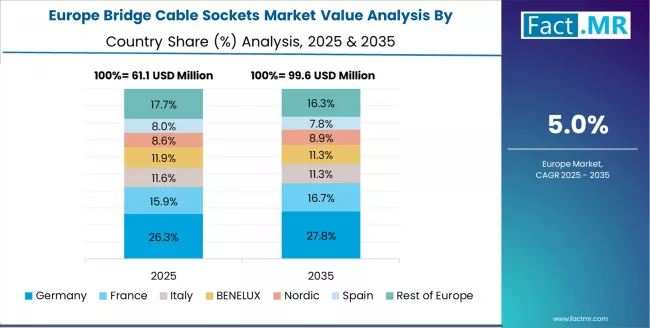
The bridge cable sockets market in Europe is projected to grow from USD 68.0 million in 2025 to USD 115.0 million by 2035, registering a CAGR of 5.4% over the forecast period. Germany is expected to maintain its leadership position with a 31.2% market share in 2025, declining slightly to 30.6% by 2035, supported by its advanced engineering industry and strong infrastructure development capabilities.
France follows with a 26.8% share in 2025, projected to reach 27.2% by 2035, driven by comprehensive infrastructure development and engineering technology industry applications. The United Kingdom holds a 22.4% share in 2025, expected to decrease to 21.9% by 2035 due to market diversification. Italy commands a 11.7% share, while Spain accounts for 5.6% in 2025. The Rest of Europe region is anticipated to gain momentum, expanding its collective share from 2.3% to 2.8% by 2035, attributed to increasing infrastructure development adoption in Nordic countries and emerging Eastern European construction markets implementing advanced bridge technologies.
Wedge Socket Applications Dominate Structural Engineering in Japan
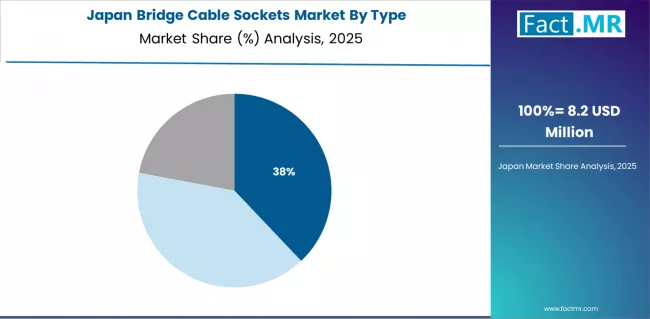
The Japanese market demonstrates a mature and precision-focused landscape, characterized by advanced integration of wedge socket technologies with existing infrastructure systems across construction facilities, engineering networks, and structural operations. Japan's focus on quality excellence and engineering precision drives demand for high-reliability cable socket solutions that support comprehensive infrastructure initiatives and regulatory requirements in construction operations. The market benefits from strong partnerships between international structural providers like Bridon-Bekaert, Valmont, and domestic infrastructure leaders, including established construction companies and engineering specialists, creating comprehensive service ecosystems that prioritize structural quality and engineering precision programs.
Steel Alloy Applications Lead Infrastructure Services in South Korea
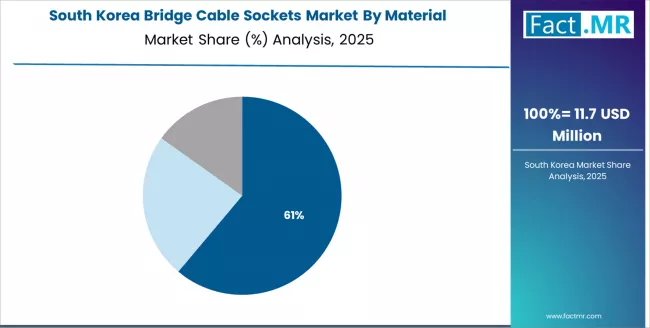
The South Korean market is characterized by strong international infrastructure application presence, with companies like Herrenknecht, DYWIDAG, and Freyssinet maintaining dominant positions through comprehensive system integration and structural services capabilities for infrastructure modernization and construction applications. The market is demonstrating a growing focus on localized infrastructure support and rapid deployment capabilities, as Korean contractors increasingly demand customized solutions that integrate with domestic infrastructure systems and advanced construction technologies deployed across major engineering centers and infrastructure facilities. Local structural companies and regional infrastructure integrators are gaining market share through strategic partnerships with global providers, offering specialized services including technical training programs and certification services for engineering specialists.
Competitive Landscape of the Bridge Cable Sockets Market
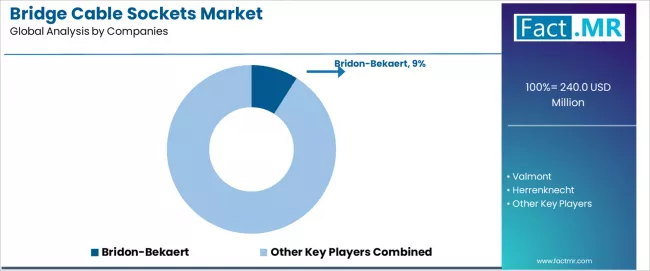
The market is characterized by competition among established structural hardware manufacturers, specialized cable system producers, and diversified infrastructure technology companies. Companies are investing in advanced socket design development, high-performance materials innovation, product portfolio expansion, and application-specific hardware development to deliver high-performance, reliable, and structurally effective cable socket solutions. Innovation in smart monitoring integration, advanced materials development, and specialized engineering systems is central to strengthening market position and competitive advantage.
Bridon-Bekaert leads the market with a 9.0% share, offering comprehensive cable socket solutions with a focus on structural applications, advanced hardware technologies, and integrated cable systems across diverse suspension bridge, cable-stayed bridge, and infrastructure distribution channels. The company has announced major technology advancement initiatives and investments in smart infrastructure integration to support growing global demand for advanced structural hardware and intelligent bridge solutions. Valmont provides innovative structural solutions with focus on engineering excellence and infrastructure technologies, while Herrenknecht delivers specialized construction products with focus on precision engineering and structural applications. DYWIDAG offers comprehensive structural solutions with cable socket offerings for multiple infrastructure categories, and Freyssinet provides advanced structural technologies with focus on bridge systems and construction optimization. VSL specializes in structural engineering solutions with advanced cable technologies, while other key players including Superbolt, Cleveland Wire, Macalloy, and Erico contribute to market competition through specialized structural capabilities and infrastructure hardware expertise.
Bridge Cable Sockets Market - Stakeholder Contribution Framework
Bridge cable sockets represent a specialized structural hardware segment within infrastructure and construction applications, projected to grow from USD 240.0 million in 2025 to USD 410.0 million by 2035 at a 5.9% CAGR. These structural hardware products primarily wedge sockets, clip sockets, and strand grip configurations for multiple applications serve as critical connection components in suspension bridges, cable-stayed bridges, infrastructure projects, and civil engineering structures where structural precision, connection safety, and load effectiveness are essential. Market expansion is driven by increasing bridge construction, growing infrastructure investment, expanding mega-project requirements, and rising demand for advanced structural solutions across diverse suspension, cable-stayed, infrastructure, and civil engineering sectors.
How Infrastructure Regulators Could Strengthen Structural Standards and Bridge Safety?
- Structural Product Standards: Establish comprehensive technical specifications for bridge cable sockets, including safety requirements, load standards, structural validation protocols, and quality guidelines that ensure consistent performance across suspension bridges, cable-stayed bridges, infrastructure projects, and civil structures.
- Bridge Safety Integration: Develop regulatory frameworks that incentivize advanced structural practices, requiring manufacturers to implement quality management systems, utilize safety validation protocols, incorporate structural protection procedures, and achieve measurable safety improvements in cable socket development.
- Quality Assurance Requirements: Implement mandatory quality control standards for cable socket manufacturing, including structural testing protocols, safety verification measures, and load validation systems that ensure product effectiveness and bridge safety across diverse structural applications.
- Infrastructure Grade Guidelines: Create specialized regulations for infrastructure-grade cable sockets used in complex bridge systems, addressing stringent safety specifications, structural requirements, and regulatory validation specific to bridge applications requiring enhanced reliability and structural protection.
- Innovation Support Programs: Provide regulatory facilitation and research incentives for development of next-generation structural technologies that improve bridge outcomes, enhance safety, and enable emerging applications in smart infrastructure and monitoring systems.
How Industry Associations Could Advance Structural Technology Standards and Market Development?
- Structural Best Practices: Develop comprehensive technical guidelines for cable socket selection, bridge optimization, and structural validation techniques that maximize connection effectiveness, ensure safety, and maintain cost-effectiveness across suspension bridges, cable-stayed bridges, and infrastructure applications.
- Bridge Safety Benchmarking: Establish industry-wide metrics for structural performance, including connection efficacy assessment, safety measurement, bridge outcome evaluation, and application documentation that enable comparative analysis and drive continuous improvement toward structural optimization objectives.
- Professional Training Programs: Create specialized education initiatives for structural engineers, bridge technicians, and construction professionals covering cable socket characteristics, structural applications, safety requirements, and connection techniques across diverse infrastructure applications.
- Structural Standardization: Develop standardized testing methodologies for cable socket evaluation, including load assessment, safety analysis, structural validation, and application-specific performance metrics that facilitate objective product comparison and structural validation.
- Infrastructure Collaboration: Facilitate partnerships between cable socket suppliers, structural contractors, research institutions, and infrastructure organizations to advance structural technology development, address emerging bridge challenges, and accelerate innovation in structural applications.
How Bridge Cable Socket Manufacturers Could Drive Innovation and Market Leadership?
- Advanced Structural Technologies: Invest in socket design enhancement, smart monitoring optimization, advanced materials development, and bridge safety improvement initiatives that enhance structural effectiveness while maintaining connection reliability and regulatory compliance in global markets.
- Specialized Product Development: Develop specialized cable sockets with enhanced structural characteristics, including optimized load capacity, improved bridge integration, increased connection efficiency, and application-specific performance attributes for emerging infrastructure segments.
- Structural Quality Integration: Implement intelligent quality control systems with real-time structural monitoring, predictive safety assessment, automated load verification, and data analytics that optimize product performance, ensure structural reliability, and reduce bridge complexity.
- Infrastructure Support Services: Establish comprehensive customer service capabilities providing technical consultation, installation assistance, structural troubleshooting, and application expertise that strengthen customer relationships and enable successful infrastructure implementation.
- Global Structural Excellence: Develop regional service networks, specialized technical support management, reliable supply systems, and responsive customer service that ensure consistent product availability, maintain structural quality, and support customer infrastructure requirements worldwide.
How End-User Industries Could Optimize Structural Performance and Bridge Success?
- Strategic Product Selection: Conduct comprehensive assessments of structural requirements, bridge needs, regulatory constraints, and operational considerations to optimize cable socket selection and achieve desired structural characteristics while managing total infrastructure costs and performance outcomes.
- Structural System Optimization: Implement advanced bridge methodologies utilizing structural validation, performance evaluation, and systematic assessment to maximize cable socket structural benefits, minimize infrastructure complexity, and optimize overall structural effectiveness and bridge satisfaction.
- Bridge Safety Management: Develop optimized structural protocols, safety control procedures, and performance validation that ensure effective cable socket utilization, maximize structural benefits, and maintain consistent bridge performance throughout operations.
- Quality Structural Integration: Incorporate structural best practices, bridge safety principles, and quality considerations into infrastructure planning and structural processes that support comprehensive bridge objectives and structural excellence.
- Strategic Structural Partnerships: Establish strategic partnerships with cable socket suppliers for joint infrastructure programs, structural optimization initiatives, and co-innovation projects that address specific bridge challenges and accelerate structural technology commercialization.
How Research Institutions Could Enable Structural Technology Advancement?
- Structural Research Programs: Conduct fundamental investigations into cable socket technology, structural mechanisms, bridge optimization, and infrastructure applications that advance structural understanding and enable breakthrough innovations in structural technology and bridge science.
- Structural Technology Development: Develop novel bridge methods, including advanced socket techniques, connection approaches, and structural enhancement technologies that improve bridge performance while maintaining safety and cost effectiveness.
- Infrastructure Application Innovation: Investigate emerging applications for cable sockets in smart bridges, monitoring integration, advanced structures, and specialized infrastructure applications that create new market opportunities and expand structural potential.
- Structural Validation Services: Provide advanced structural research services utilizing bridge validation, structural testing, performance assessment, and application evaluation methodologies that enable detailed understanding of cable socket properties and infrastructure applications.
- Structural Technology Transfer: Facilitate technology commercialization through licensing agreements, startup incubation programs, structural publications, and collaborative research projects that accelerate structural innovation adoption and strengthen industry-academia partnerships.
How Investors and Financial Enablers Could Support Structural Technology Market Growth?
- Structural Infrastructure Investment: Provide capital for cable socket manufacturing facility construction, production capacity expansion, and technology upgrade projects that address growing infrastructure demand while improving operational efficiency and structural performance.
- Structural Innovation Financing: Fund research and development of breakthrough cable socket technologies, including advanced structural methods, smart bridge systems, and novel infrastructure applications that address current market limitations and create competitive advantages.
- Structural Development Support: Finance structural technology innovation initiatives, bridge validation programs, regulatory development, and structural advancement that enhance infrastructure capabilities and position manufacturers for long-term market acceptance and growth.
- Structural Market Expansion: Support strategic acquisitions, market entry initiatives, distribution network development, and customer structural service capabilities that accelerate geographic expansion and strengthen competitive positions in high-growth infrastructure markets.
- Global Structural Development: Provide financing and technical assistance for cable socket facilities in developing economies, creating new structural supply capabilities, supporting local infrastructure development, and expanding global market access for structural solutions.
Key Players in the Bridge Cable Sockets Market
- Bridon-Bekaert
- Valmont
- Herrenknecht
- DYWIDAG
- Freyssinet
- VSL
- Superbolt
- Cleveland Wire
- Macalloy
- Erico
Scope of the Report
| Items | Values |
|---|---|
| Quantitative Units (2025) | USD 240.0 million |
| Type | Wedge Sockets, Clip Sockets, Strand Grips |
| Material | Steel Alloy, Stainless, Galvanized |
| End Use | Suspension Bridges, Cable-stayed Bridges, Other Civil Structures |
| Regions Covered | North America, Europe, Asia Pacific, Latin America, Middle East & Africa |
| Countries Covered | USA, Germany, France, UK, Japan, South Korea, Mexico, and 40+ countries |
| Key Companies Profiled | Bridon-Bekaert, Valmont, Herrenknecht, DYWIDAG, Freyssinet, VSL |
| Additional Attributes | Dollar sales by type and end use category, regional demand trends, competitive landscape, technological advancements in structural engineering, infrastructure development, construction innovation, and bridge performance optimization |
Bridge Cable Sockets Market by Segments
-
Type :
- Wedge Sockets
- Clip Sockets
- Strand Grips
-
Material :
- Steel Alloy
- Stainless
- Galvanized
-
End Use :
- Suspension Bridges
- Cable-stayed Bridges
- Other Civil Structures
-
Region :
-
North America
- United States
- Canada
- Mexico
-
Europe
- Germany
- United Kingdom
- France
- Italy
- Spain
- Netherlands
- Nordic
- BENELUX
- Rest of Europe
-
Asia Pacific
- China
- Japan
- South Korea
- India
- Australia
- Rest of Asia Pacific
-
Latin America
- Brazil
- Argentina
- Chile
- Rest of Latin America
-
Middle East & Africa
- Kingdom of Saudi Arabia
- Other GCC Countries
- Turkey
- South Africa
- Other African Union
- Rest of Middle East & Africa
-
Table of Content
- Executive Summary
- Global Market Outlook
- Demand to side Trends
- Supply to side Trends
- Technology Roadmap Analysis
- Analysis and Recommendations
- Market Overview
- Market Coverage / Taxonomy
- Market Definition / Scope / Limitations
- Market Background
- Market Dynamics
- Drivers
- Restraints
- Opportunity
- Trends
- Scenario Forecast
- Demand in Optimistic Scenario
- Demand in Likely Scenario
- Demand in Conservative Scenario
- Opportunity Map Analysis
- Product Life Cycle Analysis
- Supply Chain Analysis
- Investment Feasibility Matrix
- Value Chain Analysis
- PESTLE and Porter’s Analysis
- Regulatory Landscape
- Regional Parent Market Outlook
- Production and Consumption Statistics
- Import and Export Statistics
- Market Dynamics
- Global Market Analysis 2020 to 2024 and Forecast, 2025 to 2035
- Historical Market Size Value (USD Million) Analysis, 2020 to 2024
- Current and Future Market Size Value (USD Million) Projections, 2025 to 2035
- Y to o to Y Growth Trend Analysis
- Absolute $ Opportunity Analysis
- Global Market Pricing Analysis 2020 to 2024 and Forecast 2025 to 2035
- Global Market Analysis 2020 to 2024 and Forecast 2025 to 2035, By Type
- Introduction / Key Findings
- Historical Market Size Value (USD Million) Analysis By Type , 2020 to 2024
- Current and Future Market Size Value (USD Million) Analysis and Forecast By Type , 2025 to 2035
- Wedge Sockets
- Clip Sockets
- Strand Grips
- Y to o to Y Growth Trend Analysis By Type , 2020 to 2024
- Absolute $ Opportunity Analysis By Type , 2025 to 2035
- Global Market Analysis 2020 to 2024 and Forecast 2025 to 2035, By Material
- Introduction / Key Findings
- Historical Market Size Value (USD Million) Analysis By Material, 2020 to 2024
- Current and Future Market Size Value (USD Million) Analysis and Forecast By Material, 2025 to 2035
- Steel Alloy
- Stainless
- Galvanized
- Y to o to Y Growth Trend Analysis By Material, 2020 to 2024
- Absolute $ Opportunity Analysis By Material, 2025 to 2035
- Global Market Analysis 2020 to 2024 and Forecast 2025 to 2035, By End Use
- Introduction / Key Findings
- Historical Market Size Value (USD Million) Analysis By End Use, 2020 to 2024
- Current and Future Market Size Value (USD Million) Analysis and Forecast By End Use, 2025 to 2035
- Suspension Bridges
- Cable-stayed Bridges
- Other Civil Structures
- Y to o to Y Growth Trend Analysis By End Use, 2020 to 2024
- Absolute $ Opportunity Analysis By End Use, 2025 to 2035
- Global Market Analysis 2020 to 2024 and Forecast 2025 to 2035, By Region
- Introduction
- Historical Market Size Value (USD Million) Analysis By Region, 2020 to 2024
- Current Market Size Value (USD Million) Analysis and Forecast By Region, 2025 to 2035
- North America
- Latin America
- Western Europe
- Eastern Europe
- East Asia
- South Asia and Pacific
- Middle East & Africa
- Market Attractiveness Analysis By Region
- North America Market Analysis 2020 to 2024 and Forecast 2025 to 2035, By Country
- Historical Market Size Value (USD Million) Trend Analysis By Market Taxonomy, 2020 to 2024
- Market Size Value (USD Million) Forecast By Market Taxonomy, 2025 to 2035
- By Country
- USA
- Canada
- Mexico
- By Type
- By Material
- By End Use
- By Country
- Market Attractiveness Analysis
- By Country
- By Type
- By Material
- By End Use
- Key Takeaways
- Latin America Market Analysis 2020 to 2024 and Forecast 2025 to 2035, By Country
- Historical Market Size Value (USD Million) Trend Analysis By Market Taxonomy, 2020 to 2024
- Market Size Value (USD Million) Forecast By Market Taxonomy, 2025 to 2035
- By Country
- Brazil
- Chile
- Rest of Latin America
- By Type
- By Material
- By End Use
- By Country
- Market Attractiveness Analysis
- By Country
- By Type
- By Material
- By End Use
- Key Takeaways
- Western Europe Market Analysis 2020 to 2024 and Forecast 2025 to 2035, By Country
- Historical Market Size Value (USD Million) Trend Analysis By Market Taxonomy, 2020 to 2024
- Market Size Value (USD Million) Forecast By Market Taxonomy, 2025 to 2035
- By Country
- Germany
- UK
- Italy
- Spain
- France
- Nordic
- BENELUX
- Rest of Western Europe
- By Type
- By Material
- By End Use
- By Country
- Market Attractiveness Analysis
- By Country
- By Type
- By Material
- By End Use
- Key Takeaways
- Eastern Europe Market Analysis 2020 to 2024 and Forecast 2025 to 2035, By Country
- Historical Market Size Value (USD Million) Trend Analysis By Market Taxonomy, 2020 to 2024
- Market Size Value (USD Million) Forecast By Market Taxonomy, 2025 to 2035
- By Country
- Russia
- Poland
- Hungary
- Balkan & Baltic
- Rest of Eastern Europe
- By Type
- By Material
- By End Use
- By Country
- Market Attractiveness Analysis
- By Country
- By Type
- By Material
- By End Use
- Key Takeaways
- East Asia Market Analysis 2020 to 2024 and Forecast 2025 to 2035, By Country
- Historical Market Size Value (USD Million) Trend Analysis By Market Taxonomy, 2020 to 2024
- Market Size Value (USD Million) Forecast By Market Taxonomy, 2025 to 2035
- By Country
- China
- Japan
- South Korea
- By Type
- By Material
- By End Use
- By Country
- Market Attractiveness Analysis
- By Country
- By Type
- By Material
- By End Use
- Key Takeaways
- South Asia and Pacific Market Analysis 2020 to 2024 and Forecast 2025 to 2035, By Country
- Historical Market Size Value (USD Million) Trend Analysis By Market Taxonomy, 2020 to 2024
- Market Size Value (USD Million) Forecast By Market Taxonomy, 2025 to 2035
- By Country
- India
- ASEAN
- Australia & New Zealand
- Rest of South Asia and Pacific
- By Type
- By Material
- By End Use
- By Country
- Market Attractiveness Analysis
- By Country
- By Type
- By Material
- By End Use
- Key Takeaways
- Middle East & Africa Market Analysis 2020 to 2024 and Forecast 2025 to 2035, By Country
- Historical Market Size Value (USD Million) Trend Analysis By Market Taxonomy, 2020 to 2024
- Market Size Value (USD Million) Forecast By Market Taxonomy, 2025 to 2035
- By Country
- Kingdom of Saudi Arabia
- Other GCC Countries
- Turkiye
- South Africa
- Other African Union
- Rest of Middle East & Africa
- By Type
- By Material
- By End Use
- By Country
- Market Attractiveness Analysis
- By Country
- By Type
- By Material
- By End Use
- Key Takeaways
- Key Countries Market Analysis
- USA
- Pricing Analysis
- Market Share Analysis, 2024
- By Type
- By Material
- By End Use
- Canada
- Pricing Analysis
- Market Share Analysis, 2024
- By Type
- By Material
- By End Use
- Mexico
- Pricing Analysis
- Market Share Analysis, 2024
- By Type
- By Material
- By End Use
- Brazil
- Pricing Analysis
- Market Share Analysis, 2024
- By Type
- By Material
- By End Use
- Chile
- Pricing Analysis
- Market Share Analysis, 2024
- By Type
- By Material
- By End Use
- Germany
- Pricing Analysis
- Market Share Analysis, 2024
- By Type
- By Material
- By End Use
- UK
- Pricing Analysis
- Market Share Analysis, 2024
- By Type
- By Material
- By End Use
- Italy
- Pricing Analysis
- Market Share Analysis, 2024
- By Type
- By Material
- By End Use
- Spain
- Pricing Analysis
- Market Share Analysis, 2024
- By Type
- By Material
- By End Use
- France
- Pricing Analysis
- Market Share Analysis, 2024
- By Type
- By Material
- By End Use
- India
- Pricing Analysis
- Market Share Analysis, 2024
- By Type
- By Material
- By End Use
- ASEAN
- Pricing Analysis
- Market Share Analysis, 2024
- By Type
- By Material
- By End Use
- Australia & New Zealand
- Pricing Analysis
- Market Share Analysis, 2024
- By Type
- By Material
- By End Use
- China
- Pricing Analysis
- Market Share Analysis, 2024
- By Type
- By Material
- By End Use
- Japan
- Pricing Analysis
- Market Share Analysis, 2024
- By Type
- By Material
- By End Use
- South Korea
- Pricing Analysis
- Market Share Analysis, 2024
- By Type
- By Material
- By End Use
- Russia
- Pricing Analysis
- Market Share Analysis, 2024
- By Type
- By Material
- By End Use
- Poland
- Pricing Analysis
- Market Share Analysis, 2024
- By Type
- By Material
- By End Use
- Hungary
- Pricing Analysis
- Market Share Analysis, 2024
- By Type
- By Material
- By End Use
- Kingdom of Saudi Arabia
- Pricing Analysis
- Market Share Analysis, 2024
- By Type
- By Material
- By End Use
- Turkiye
- Pricing Analysis
- Market Share Analysis, 2024
- By Type
- By Material
- By End Use
- South Africa
- Pricing Analysis
- Market Share Analysis, 2024
- By Type
- By Material
- By End Use
- USA
- Market Structure Analysis
- Competition Dashboard
- Competition Benchmarking
- Market Share Analysis of Top Players
- By Regional
- By Type
- By Material
- By End Use
- Competition Analysis
- Competition Deep Dive
- Bridon-Bekaert
- Overview
- Product Portfolio
- Profitability by Market Segments (Product/Age /Sales Channel/Region)
- Sales Footprint
- Strategy Overview
- Marketing Strategy
- Product Strategy
- Channel Strategy
- Valmont
- Herrenknecht
- DYWIDAG
- Freyssinet
- VSL
- Superbolt
- Cleveland Wire
- Macalloy
- Erico
- Bridon-Bekaert
- Competition Deep Dive
- Assumptions & Acronyms Used
- Research Methodology
List Of Table
- Table 1: Global Market Value (USD Million) Forecast by Region, 2020 to 2035
- Table 2: Global Market Value (USD Million) Forecast by Type , 2020 to 2035
- Table 3: Global Market Value (USD Million) Forecast by Material, 2020 to 2035
- Table 4: Global Market Value (USD Million) Forecast by End Use, 2020 to 2035
- Table 5: North America Market Value (USD Million) Forecast by Country, 2020 to 2035
- Table 6: North America Market Value (USD Million) Forecast by Type , 2020 to 2035
- Table 7: North America Market Value (USD Million) Forecast by Material, 2020 to 2035
- Table 8: North America Market Value (USD Million) Forecast by End Use, 2020 to 2035
- Table 9: Latin America Market Value (USD Million) Forecast by Country, 2020 to 2035
- Table 10: Latin America Market Value (USD Million) Forecast by Type , 2020 to 2035
- Table 11: Latin America Market Value (USD Million) Forecast by Material, 2020 to 2035
- Table 12: Latin America Market Value (USD Million) Forecast by End Use, 2020 to 2035
- Table 13: Western Europe Market Value (USD Million) Forecast by Country, 2020 to 2035
- Table 14: Western Europe Market Value (USD Million) Forecast by Type , 2020 to 2035
- Table 15: Western Europe Market Value (USD Million) Forecast by Material, 2020 to 2035
- Table 16: Western Europe Market Value (USD Million) Forecast by End Use, 2020 to 2035
- Table 17: Eastern Europe Market Value (USD Million) Forecast by Country, 2020 to 2035
- Table 18: Eastern Europe Market Value (USD Million) Forecast by Type , 2020 to 2035
- Table 19: Eastern Europe Market Value (USD Million) Forecast by Material, 2020 to 2035
- Table 20: Eastern Europe Market Value (USD Million) Forecast by End Use, 2020 to 2035
- Table 21: East Asia Market Value (USD Million) Forecast by Country, 2020 to 2035
- Table 22: East Asia Market Value (USD Million) Forecast by Type , 2020 to 2035
- Table 23: East Asia Market Value (USD Million) Forecast by Material, 2020 to 2035
- Table 24: East Asia Market Value (USD Million) Forecast by End Use, 2020 to 2035
- Table 25: South Asia and Pacific Market Value (USD Million) Forecast by Country, 2020 to 2035
- Table 26: South Asia and Pacific Market Value (USD Million) Forecast by Type , 2020 to 2035
- Table 27: South Asia and Pacific Market Value (USD Million) Forecast by Material, 2020 to 2035
- Table 28: South Asia and Pacific Market Value (USD Million) Forecast by End Use, 2020 to 2035
- Table 29: Middle East & Africa Market Value (USD Million) Forecast by Country, 2020 to 2035
- Table 30: Middle East & Africa Market Value (USD Million) Forecast by Type , 2020 to 2035
- Table 31: Middle East & Africa Market Value (USD Million) Forecast by Material, 2020 to 2035
- Table 32: Middle East & Africa Market Value (USD Million) Forecast by End Use, 2020 to 2035
List Of Figures
- Figure 1: Global Market Pricing Analysis
- Figure 2: Global Market Value (USD Million) Forecast 2020-2035
- Figure 3: Global Market Value Share and BPS Analysis by Type , 2025 and 2035
- Figure 4: Global Market Y to o to Y Growth Comparison by Type , 2025-2035
- Figure 5: Global Market Attractiveness Analysis by Type
- Figure 6: Global Market Value Share and BPS Analysis by Material, 2025 and 2035
- Figure 7: Global Market Y to o to Y Growth Comparison by Material, 2025-2035
- Figure 8: Global Market Attractiveness Analysis by Material
- Figure 9: Global Market Value Share and BPS Analysis by End Use, 2025 and 2035
- Figure 10: Global Market Y to o to Y Growth Comparison by End Use, 2025-2035
- Figure 11: Global Market Attractiveness Analysis by End Use
- Figure 12: Global Market Value (USD Million) Share and BPS Analysis by Region, 2025 and 2035
- Figure 13: Global Market Y to o to Y Growth Comparison by Region, 2025-2035
- Figure 14: Global Market Attractiveness Analysis by Region
- Figure 15: North America Market Incremental Dollar Opportunity, 2025-2035
- Figure 16: Latin America Market Incremental Dollar Opportunity, 2025-2035
- Figure 17: Western Europe Market Incremental Dollar Opportunity, 2025-2035
- Figure 18: Eastern Europe Market Incremental Dollar Opportunity, 2025-2035
- Figure 19: East Asia Market Incremental Dollar Opportunity, 2025-2035
- Figure 20: South Asia and Pacific Market Incremental Dollar Opportunity, 2025-2035
- Figure 21: Middle East & Africa Market Incremental Dollar Opportunity, 2025-2035
- Figure 22: North America Market Value Share and BPS Analysis by Country, 2025 and 2035
- Figure 23: North America Market Value Share and BPS Analysis by Type , 2025 and 2035
- Figure 24: North America Market Y to o to Y Growth Comparison by Type , 2025-2035
- Figure 25: North America Market Attractiveness Analysis by Type
- Figure 26: North America Market Value Share and BPS Analysis by Material, 2025 and 2035
- Figure 27: North America Market Y to o to Y Growth Comparison by Material, 2025-2035
- Figure 28: North America Market Attractiveness Analysis by Material
- Figure 29: North America Market Value Share and BPS Analysis by End Use, 2025 and 2035
- Figure 30: North America Market Y to o to Y Growth Comparison by End Use, 2025-2035
- Figure 31: North America Market Attractiveness Analysis by End Use
- Figure 32: Latin America Market Value Share and BPS Analysis by Country, 2025 and 2035
- Figure 33: Latin America Market Value Share and BPS Analysis by Type , 2025 and 2035
- Figure 34: Latin America Market Y to o to Y Growth Comparison by Type , 2025-2035
- Figure 35: Latin America Market Attractiveness Analysis by Type
- Figure 36: Latin America Market Value Share and BPS Analysis by Material, 2025 and 2035
- Figure 37: Latin America Market Y to o to Y Growth Comparison by Material, 2025-2035
- Figure 38: Latin America Market Attractiveness Analysis by Material
- Figure 39: Latin America Market Value Share and BPS Analysis by End Use, 2025 and 2035
- Figure 40: Latin America Market Y to o to Y Growth Comparison by End Use, 2025-2035
- Figure 41: Latin America Market Attractiveness Analysis by End Use
- Figure 42: Western Europe Market Value Share and BPS Analysis by Country, 2025 and 2035
- Figure 43: Western Europe Market Value Share and BPS Analysis by Type , 2025 and 2035
- Figure 44: Western Europe Market Y to o to Y Growth Comparison by Type , 2025-2035
- Figure 45: Western Europe Market Attractiveness Analysis by Type
- Figure 46: Western Europe Market Value Share and BPS Analysis by Material, 2025 and 2035
- Figure 47: Western Europe Market Y to o to Y Growth Comparison by Material, 2025-2035
- Figure 48: Western Europe Market Attractiveness Analysis by Material
- Figure 49: Western Europe Market Value Share and BPS Analysis by End Use, 2025 and 2035
- Figure 50: Western Europe Market Y to o to Y Growth Comparison by End Use, 2025-2035
- Figure 51: Western Europe Market Attractiveness Analysis by End Use
- Figure 52: Eastern Europe Market Value Share and BPS Analysis by Country, 2025 and 2035
- Figure 53: Eastern Europe Market Value Share and BPS Analysis by Type , 2025 and 2035
- Figure 54: Eastern Europe Market Y to o to Y Growth Comparison by Type , 2025-2035
- Figure 55: Eastern Europe Market Attractiveness Analysis by Type
- Figure 56: Eastern Europe Market Value Share and BPS Analysis by Material, 2025 and 2035
- Figure 57: Eastern Europe Market Y to o to Y Growth Comparison by Material, 2025-2035
- Figure 58: Eastern Europe Market Attractiveness Analysis by Material
- Figure 59: Eastern Europe Market Value Share and BPS Analysis by End Use, 2025 and 2035
- Figure 60: Eastern Europe Market Y to o to Y Growth Comparison by End Use, 2025-2035
- Figure 61: Eastern Europe Market Attractiveness Analysis by End Use
- Figure 62: East Asia Market Value Share and BPS Analysis by Country, 2025 and 2035
- Figure 63: East Asia Market Value Share and BPS Analysis by Type , 2025 and 2035
- Figure 64: East Asia Market Y to o to Y Growth Comparison by Type , 2025-2035
- Figure 65: East Asia Market Attractiveness Analysis by Type
- Figure 66: East Asia Market Value Share and BPS Analysis by Material, 2025 and 2035
- Figure 67: East Asia Market Y to o to Y Growth Comparison by Material, 2025-2035
- Figure 68: East Asia Market Attractiveness Analysis by Material
- Figure 69: East Asia Market Value Share and BPS Analysis by End Use, 2025 and 2035
- Figure 70: East Asia Market Y to o to Y Growth Comparison by End Use, 2025-2035
- Figure 71: East Asia Market Attractiveness Analysis by End Use
- Figure 72: South Asia and Pacific Market Value Share and BPS Analysis by Country, 2025 and 2035
- Figure 73: South Asia and Pacific Market Value Share and BPS Analysis by Type , 2025 and 2035
- Figure 74: South Asia and Pacific Market Y to o to Y Growth Comparison by Type , 2025-2035
- Figure 75: South Asia and Pacific Market Attractiveness Analysis by Type
- Figure 76: South Asia and Pacific Market Value Share and BPS Analysis by Material, 2025 and 2035
- Figure 77: South Asia and Pacific Market Y to o to Y Growth Comparison by Material, 2025-2035
- Figure 78: South Asia and Pacific Market Attractiveness Analysis by Material
- Figure 79: South Asia and Pacific Market Value Share and BPS Analysis by End Use, 2025 and 2035
- Figure 80: South Asia and Pacific Market Y to o to Y Growth Comparison by End Use, 2025-2035
- Figure 81: South Asia and Pacific Market Attractiveness Analysis by End Use
- Figure 82: Middle East & Africa Market Value Share and BPS Analysis by Country, 2025 and 2035
- Figure 83: Middle East & Africa Market Value Share and BPS Analysis by Type , 2025 and 2035
- Figure 84: Middle East & Africa Market Y to o to Y Growth Comparison by Type , 2025-2035
- Figure 85: Middle East & Africa Market Attractiveness Analysis by Type
- Figure 86: Middle East & Africa Market Value Share and BPS Analysis by Material, 2025 and 2035
- Figure 87: Middle East & Africa Market Y to o to Y Growth Comparison by Material, 2025-2035
- Figure 88: Middle East & Africa Market Attractiveness Analysis by Material
- Figure 89: Middle East & Africa Market Value Share and BPS Analysis by End Use, 2025 and 2035
- Figure 90: Middle East & Africa Market Y to o to Y Growth Comparison by End Use, 2025-2035
- Figure 91: Middle East & Africa Market Attractiveness Analysis by End Use
- Figure 92: Global Market - Tier Structure Analysis
- Figure 93: Global Market - Company Share Analysis
- FAQs -
How big is the bridge cable sockets market in 2025?
The global bridge cable sockets market is estimated to be valued at USD 240.0 million in 2025.
What will be the size of bridge cable sockets market in 2035?
The market size for the bridge cable sockets market is projected to reach USD 425.8 million by 2035.
How much will be the bridge cable sockets market growth between 2025 and 2035?
The bridge cable sockets market is expected to grow at a 5.9% CAGR between 2025 and 2035.
What are the key product types in the bridge cable sockets market?
The key product types in bridge cable sockets market are wedge sockets, clip sockets and strand grips.
Which material segment to contribute significant share in the bridge cable sockets market in 2025?
In terms of material, steel alloy segment to command 62.0% share in the bridge cable sockets market in 2025.